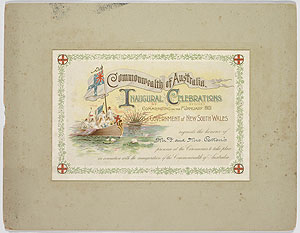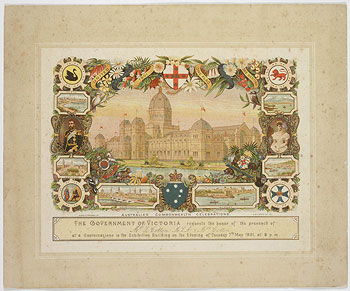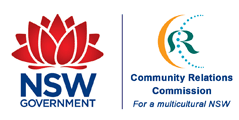Commonwealth of Australia created under Federal Constitution. White Australia Policy formalised in Immigration Restriction Act.

Invitations to Australian Commonwealth Celebrations, Francis Cotton, 1901, MLMSS 2509X, Mitchell Library, State Library of New South Wales
Before 1900, there was no actual country called Australia, only the six colonies – New South Wales, Tasmania, South Australia, Victoria, Queensland, and Western Australia. While these colonies were on the same continent, they were governed like six rival countries and there was little communication between them. Until the 1880s, there was limited interest in the idea of uniting the colonies into one country and the influential businessmen in the colonies seemed more interested in protecting their own economic bases.
Things began to change in the 1890s as a severe drought resulted in violent industrial strikes. By 1888, 70% of the population had been born here and there was a growing nationalist sentiment. Communication had improved with the colonies linked to each other and the world by overland and submarine telegraph. Germany, France and Russia were expanding in the Pacific and the colonies could better defend themselves with a single army and navy. Thousands of Chinese migrants came to Australia during the gold rush. People wanted to restrict the economic competition of migrants from Asia. The best way to do this was for all the colonies to act together and work out a common immigration policy.
Uniting the six colonies was not easy, with many fights and walkouts in negotiations along the way. After a series of conferences and meetings, a draft Australian Federal Constitution was drawn up. A series of referendums was put to the people until finally, in 1900; there was a majority agreement for Federation. The Commonwealth of Australia was proclaimed on 1 January 1901 at a grand ceremony in Sydney’s Centennial Park. People were proud to be Australians and thought their country was the land of opportunity. Australia was part of the British Empire and in 1907 Australia, Canada, South Africa and New Zealand became known as dominions. However, while Australians elected a parliament that made Australian laws, Britain – the ‘mother country’ – kept a firm control over defence and foreign policy. Australia did not have its own navy and could not make treaties with other nations.

Invitations to Australian Commonwealth Celebrations, Francis Cotton, 1901, MLMSS 2509X, Mitchell Library, State Library of New South Wales
But Australia was getting its own ideas. It was especially concerned that Britain did not have strong military bases in the Pacific and that Britain had signed a treaty with Japan which Australia feared. As a result, Australia began to build up its own navy in 1909.
In 1901, 98% of the population was white and Australia wanted to remain a country of white people living by British customs. Trade unions were keen to prevent labour competition from migrants who they feared would undercut wages. Consequently, one of the first pieces of legislation passed in the new Federal Parliament was the Immigration Restriction Act. Now known as the infamous White Australia Policy it made it virtually impossible for Asians and Pacific Islanders to migrate to Australia. This Act stated that if a person wanted to migrate to Australia they had to be given a dictation test which could be in any European language. So a person from China or Japan who wanted to live in Australia could be tested in one or all of the French, Italian or English languages. In 1905, the Act was changed so it could be given in any language at all. Of course, most Asians failed the test or were only allowed to enter the country under very strict exclusion rules or if they were fortunate enough to have well-connected sponsors.

